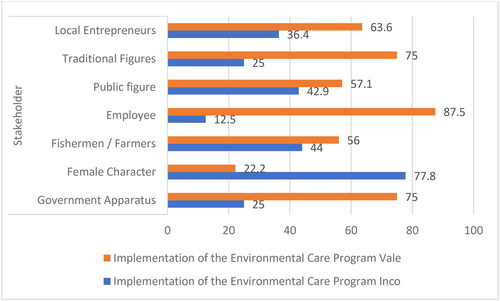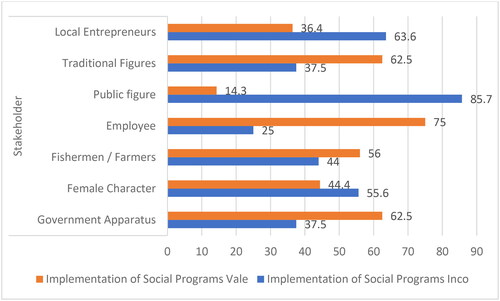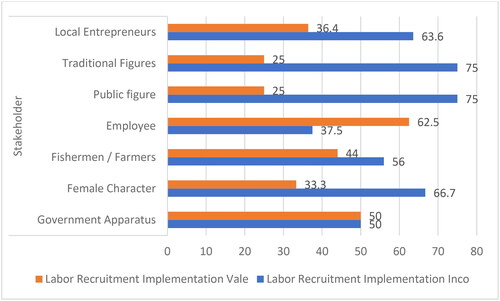Abstract
One of the prominent mining companies in Indonesia, PT Vale, have invested in vast corporate social responsibility programs in the fields of environment protection, social livelihood, employment, and economic resilience towards locals in mining areas. However, a common perception held among stakeholders have concluded that PT Vale could display greater care for its social programs, which would incorporate the interests of the community. Utilizing contemporary studies on stakeholder theory, this research provides insights of the mining industry, which have been expressed by vast stakeholders including government and Non-Government Organizations, in relation to aspects to consider before granting mining business licenses in the future. In doing so, it compares social programs between the current mining company (PT Vale) and the past (PT Inco), and determines what practices were favored by interest groups. After the distribution of questionnaires to four mine-affect areas in East Luwu Regency, Indonesia, government elites, community leaders, women figures, indigenous people, fishermen, local contractors and PT Vale employees perceived that in 2023, PT Vale have shown great progress in social, environmental management, and economic conditions compared to past mining companies. However, it founds that locals perceive a major deficiency, which is the low rate of local worker absorptions. This study contributes to the discourse of corporate social responsibility, and reveals community perceptions towards mining companies in affected areas.
1. Introduction
Mining companies are engines to state development. As Max Planck, a world-renowned physicist stated during the 2000 World Mining Conference in America: ‘Mining is not everything, but without mining, everything is nothing’ (Dubiński, Citation2013). The mining of coal, nickel, copper, iron, silver, gold, manganese, and petroleum have significantly contributed to the modernization of human civilization. The agriculture, plantation, transportation, health, cosmetics, and defense sectors rely heavily on mining products to drive innovation and productivity. As many developmentalists claim, the mining sector is the engine of development because it increases income, creates jobs, improves welfare, reduces poverty, and overcomes regional disparities (Fitzpatrick et al., Citation2011; Kurlander, Citation2001).
However, with enterprises primarily focusing on increasing production volumes, the negative impacts of mining operations tend to be overlooked. Those against its practices tend to originate from professions of environmental activists, academics, journalists, and young liberal-driven individuals. Nonetheless, the movement is not populist. They are only considered as an insignificant voice to stop mining activities which are fully supported by the government and law enforcement. During the history of resistance to mining activities in Indonesia, there has been no attempt to stop mining industry operations completely (Erb, Citation2016; Libassi, Citation2022). In a more contemporary setting, past studies have made it clear of the nexus between mining practices to the undermining of human rights in parts all over the world (Buhmann, Citation2023; Maier et al., Citation2014; Urbina & Schäfer, Citation2024). The studies argued how social rifts, physical and situational scarcity tend to be the conditions generated in mining areas, thus heavily impacting the human rights of locals affected by such operations. This eventually causes a discurive problem for mining companies, in which operations in this industry must consider the needs of locals in order to ensure sustainability of operations.
Globalization has further complexified mining operations within a state’s borders. Products produced from mining are not solely made to meet the needs of the community but become commodities that are sold globally. Mining products, which Rosa Luxemburg calls the essence of imperialism and colonialism, are caused by the unavoidable relationship between supply and demand worldwide (Luxemburg, Citation2003). The nexus between global mining demands to third-world countries is best referred to by the geographer, David Harvey, as ‘accumulation by dispossession’ (Harvey, Citation2005). Therefore, it is now a critical time to consider how mining companies implement corporate social responsibility (CSR) program that converges to the needs of locals in affected areas. Unsuprisingly, this has been a major theme within relevant academic discourses. Studies have found that CSR contains critical roles when it comes to the mining sectors. Most have been vocal on its nexus with the economic growth of locals, but have also been critical of its role in advancing social and environmental aspects of a mining company’s area of operation (Buhmann, Citation2023; Yousefian et al., Citation2023).
In doing so, this article argues the importance of a stakeholder approach. It discusses how socially responsible policies can address sustainability concerns vis-à-vis mining operations. Several examples include environmental degradation, social vulnerability, and inequality (Mutti et al., Citation2012). This study incorporates two theoretical frameworks on stekaholder theory into this study. First, how the stakeholder theory argues that the society wil support a company as long as there is a visible value given throughout the operations (Freudenreich et al., Citation2020). Second, that organizations consider the stakeholder interests (Gilbert & Rasche, Citation2008). In connection to those arguments, this study defends the importance of stakeholder management theory for mining companies, in which organizations are expected to identify the stakeholders relevant to a mining operation, understand those stakeholders’ expectations, and plan in accordance. However, this study will look specifically at the stakeholders’ perceptions of existing programs, rather than the process of constructing CSR programs.
Due to this rising concern, the mining industry is under constant pressure (Moomen & Dewan, Citation2017), and academic interest in studying the subject has grown exponentially. It is not surprising that the importance of CSR and stakeholder engagement in the mining business is increasing (Ansu-Mensah et al., Citation2021). Stakeholder engagement, seen as constructive and positive engagement between a company and its stakeholders (Matikainen, Citation2022), is at the heart of effective social responsibility and sustainability (Strand et al., Citation2015).
Having said that, this brings the importance of the stakeholders’ interest theory in further deciphering CSR programs across mining companies. This pressures organizations to adopt a normative framework in which companies must be responsible to the public. According to the theory of stakeholders’ interest, the company is looked at as an ‘entity abstract’ in which various interest meet, and not as a mere ‘contract’ (Garriga & Melé, Citation2004).
In this regard, concern for social responsibility in the mining industry is becoming an increasingly important issue (Devenin & Bianchi, Citation2018). The industry must recognize the needs and expectations of stakeholders and embrace them, by incorporating it in the decision-making process (Hąbek & Wolniak, Citation2016), so that in implementing operations, shared values are created together and the industry responds to the challenges it faces (Rodrigues & Mendes, Citation2018). Therefore, social responsibility is considered to include: internal dimensions related to health, safety, human resources, quality management, change management, and natural resource management; and the external dimension which includes local communities, business partners, public authorities, non-profit organizations (NGOs) and the environment (Amponsah-Tawiah & Mensah, Citation2015).
Previous studies targeting stakeholders have reported that local communities highly expect social responsibility from the mining industry (Imbun, Citation2007; Kepore & Imbun, Citation2011; Sharma & Bhatnagar, Citation2015), and have shown that CSR actions appear to have significant environmental impacts (Ansu-Mensah et al., Citation2021). The response of the local community around is a driving tool to gain local legitimacy (Gifford & Kestler, Citation2008; Mzembe & Meaton, Citation2014; Raufflet et al., Citation2014), which can be achieved through social investment in tangible and intangible resources (Owen & Kemp, Citation2012). However, there must be a balance between social concerns and environmental protection requirements and the profit needs of the mining industry (Jenkins, Citation2004), which presents additional challenges (Govindan et al., Citation2014).
In regards to mining and the social responsibility of industries, this discourse continues to produce rich empirical insights. Several topics have been discussed in previous studies, such as the relationship between social responsibility and the perceived impacts of mining (Viveros, Citation2016), practical social responsibility initiatives (Govindan et al., Citation2014), stakeholder engagement (Ventura & Saenz, Citation2015), resistance (Moomen & Dewan, Citation2017) and initiatives arising from the country’s mining industry (Imbun, Citation2007; Mzembe & Meaton, Citation2014). Management actions must be aligned with the needs of the environment and stakeholders, as the creation of economic value through current stakeholder interests can lead to an unequal distribution of present and future resources that is unsustainable (Matikainen, Citation2022).
In addition, the opportunity to report on sustainable development in the mining industry has been widely recognized (Jonek-Kowalska, Citation2016), with increasing expectations of operational transparency and stakeholder engagement (Hąbek & Wolniak, Citation2016). This recognition is related to the company’s need to demonstrate its commitment to social responsibility based on clear and verifiable data and information (Hąbek & Wolniak, Citation2016), so as to gain legitimacy with stakeholders and society in general (Amoako et al., Citation2017).
Past studies on this topic is considered in understanding the CSR programs of one of Indonesia’s giant mining company, PT Vale. PT Vale in the last ten years has been trying to provide real programs in environmental, social, employment, and economic aspects. However, by existence, various stakeholders still often question the performance of PT Vale either directly or indirectly and there is an opinion that the management of the previous company was considered better. This study seeks to quantitatively prove the perceptions of interest groups in East Luwu Regency regarding the comparison of CSR management of PT Vale with previous companies in providing CSR benefits.
2. Methods
Measuring the CSR benefits of mining companies to local communities was determined using the following methods: questionnaire survey, statistical data analysis, secondary data review, and interpretation. These methods are used in accordance with what previous scholars have done in the literature (Asare & Darkoh, Citation2001; Yang & Ho, Citation2019). The relevant methods were adopted to analyze the situation in Indonesia.
To conduct this research, primary data was collected in March 2023 through the distribution of questionnaires in four areas namely Nuha, Towuti, Malili and Wasuponda sub-districts located in East Luwu Regency, Indonesia. These areas are exploration sites (mine-affected areas) and recipients of CSR programs for approximately 54 years since the existence of PT Inco. Tbk and PT Vale Indonesia Tbk. The approach used was a survey strategy with a quota or purposive sample of 79 people with representation from government elites (village and sub-district governments), community/religious leaders, women leaders, indigenous peoples, farmers/fishermen, local entrepreneurs/contractors, and employees of PT Vale Indonesia Tbk. The characteristics of respondents can be seen in below.
Table 1. Respondents characteristics.
This study aims to reveal stakeholder perceptions. Therefore, the utilized combination of methods allows for a holistic overview on how such stakeholders perceive existing CSR programs in the region. The purposive sampling used for this study represents different stakeholder diversities, which incorporates varying ages, education status, and gender. This diversification is aimed to eliminate as much bias as possible.
The relationship between the personal characteristics of respondents with age, education status, and occupation provides the results of respondents’ perceptions as stakeholder representatives in assessing the comparison of CSR management of two companies that have been operating in the region. Perceptions were assessed based on their representation as stakeholders and the comparison of CSR management as seen from environmental awareness programs, implementation of social programs, implementation of workforce recruitment, and improvement of economic conditions. The data obtained were then analyzed by descriptive statistics and displayed in graphs in the discussion of this research, after obtaining the ethics approval from Universitas Hasanuddin, reference number 00323/UN4.22/PT.01.03/2023.
3. Results
Mining is one of the various economic development activities that lead to national development which will improve people’s welfare. Still, in its implementation, it is vulnerable to pollution or environmental destruction (Kepore & Imbun, Citation2011). Therefore, CSR is becoming an increasingly common discourse in the world of mining business in Indonesia. CSR is an activity carried out by companies to achieve social and environmental performance (Ansu-Mensah et al., Citation2021).
PT Vale Indonesia is among the companies that have carried out CSR programs. This represents the company’s decisiveness and accountability to the stakeholder’s interests in mining-affected areas of the East Luwu Regency. Through CSR, PT Vale ensures that the operation of the business result to sustainability. PT Vale is committed to creating ‘Practice Sustainable Mining’ in every process of the business through the Sustainable Roadmap (Vale, Citation2021). The company believes that applying the principle of sustainability in every business process can build economic, social, and environmental as well as mitigate the impacts of operations in a thorough manner.
Vale Global has an agenda and roadmap toward carbon neutrality in 2050. To support this, PT Vale has established a Sustainability Strategy that supports the 2030 Vale Global Agenda on commitments to climate change, energy, water, forests, social contributions, and Environmental, Social and Governance gaps (Vale, Citation2021). There are two models of responsibility programmed by PT Vale, namely commitment to the environment life and bearing answers to social and societal matters. A detailed list can be found in the below.
Table 2. PT Vale Indonesia’s responsibility program model.
below outlines PT Vale’s social responsibility programs, as reported in the 2021 annual report:
Table 3. Social responsibility activities of PT Vale.
In the following, the results of a survey conducted with local communities in four sub-districts affected by mining activities are presented to assess the comparative benefits of CSR implemented by PT Vale (a company currently actively managing mines in East Luwu) with the previous company, namely PT Inco. The comparative dimension is seen from the point of view of CSR management, namely in the aspects of implementing awareness programs for the environment, implementing social programs, implementing workforce recruitment, and improving economic conditions.
3.1. Policy manifestations to environment concerns
One of the responsibilities of a mining company is to ensure that CSR programs are carried out to accommodate the principles of environmental protection and management. Management of the environment must be carried out before, during, and after mining activities are carried out in an area. One of the mandated obligations of this company is based on Indonesian constitution of ‘Permen LH No. 16 of 2012’ regarding the Preparation of Environmental Documents. As a requirement for applying for a mining permit, a company needs to prepare Amdal, UKL, and UPL documents, or a Statement of Commitment to Manage the Environment.
PT Vale and PT Inco in its exploration process has become leading companies that sets a good example in environmental management. It’s just that with a change in management, it is necessary to know the public’s perception regarding the management practices carried out. Because perceptions always influence interactions with resource systems and relate to their management and regulation (Allendorf et al., Citation2006; Ormsby & Kaplin, Citation2005; Ramakrishnan, Citation2007; Vodouhê et al., Citation2010).
From the results of the descriptive analysis in , the public perceives favorable to PT Vale with a figure of 60.53 percent. While those who perceive that PT Inco is better at managing the environment only by 39.47 percent. This shows that the environmental management carried out by PT Vale is perceived by the local community as better than during PT Inco. In order to find out in more detail regarding community perceptions in areas affected by the mine, shows community assessments in the four sub-districts regarding environmental management in mine areas.
Figure 1. Community perceptions of comparison of CSR benefits of PT Vale and PT Inco.
Source: Primary Data Processing, March 2023.
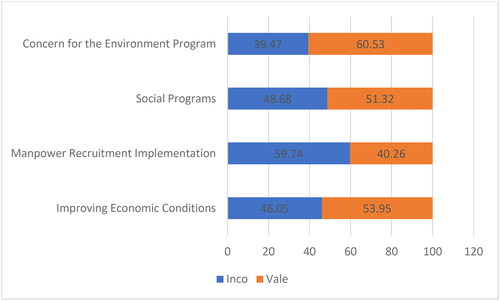
Figure 2. Community perceptions in four districts on environmental management.
Source: Primary Data Processing, March 2023.

By a crosstab analysis in , it can be understood that in Malili District, perceptions towards PT Inco and PT Vale is similar at 50 percent. In the Wasuponda District, only 30 percent of respondents considered PT Inco is better at environmental management, while 70 percent of the respondents rated PT Vale is better at environmental management. Furthermore, in Towuti District, as many as 42.1 percent of respondents considered PT Inco is better at managing the environment while 57 percent of the respondents favored PT Vale. Finally, in Nuha District, where the company’s smelter is located, 35.3 percent considered PT Inco is better, while PT Vale as much as 57.9 percent. Data analysis for each of these regions shows that in the area farthest from the company’s smelter, environmental management is still considered balanced between the PT Inco and PT Vale. While the area closest to the factory, PT Vale is favorable compared to PT Inco, even though the data for the Towuti sub-district is still somewhat balanced.
Apart from being based on region, people’s perceptions of environmental management can also be reviewed from the point of view of various interest groups. The data can be seen in below.
3.2. Implementation of social programs
In addition to the company’s commitment to protecting the environment around the mine, policy manifestation to CSR programs have also focused on improving social conditions. Some of the expected impacts on social aspects include significant attention to the needs of the surrounding community, establishment of good relations between companies and interest groups, provision of supporting facilities, and various educational scholarship programs. As in the Indonesian regulation PP No. 15/2010 concerning the acceleration of response to poverty; Article 1 reads that poverty alleviation programs are activities carried out by the government, local governments, private enterprises, and the community to improve the welfare of the poor through social assistance, community empowerment, empowerment of micro and small economic enterprises, and other programs in the framework of increasing economic activity.
In an effort to improve the welfare of local communities, PT Vale and its former company PT Inco have implemented various social assistance programs. The data in shows that respondents assess the social programs of PT Vale is slightly better than PT Inco as much as 51.32 percent. Where respondents rated Inco at 48.68 percent, this shows that the social assistance program carried out by PT Vale has not had a significant impact on the affected local communities because there are still many respondents who see programs from PT Inco whose values provide great benefits to society.
In order to find out in more detail the perceptions of local communities regarding the implementation of social assistance programs, shows the perceptions of the community in each area affected by mining activities.
Figure 4. Community perceptions in four districts of the social assistance program.
Source: Primary Data Processing, March 2023.
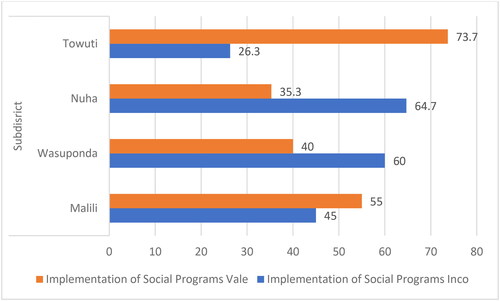
From the data in , it can be seen that respondents in the Malili sub-district assessed the social programs of PT Vale is slightly better namely PT Vale is rated at 55 percent while PT Inco 45 percent. This condition is in line with the data in Towuti District, in fact as many as 73.7 percent of PT Vale’s respondents did much better than PT Inco which is only valued at 26.3 percent. While conditions are different in Wasuponda District and Nuha District. Namely, in the Wasuponda sub-district, as much as 60 percent of the respondents favours PT Inco, while PT Vale is only 40 percent. What is interesting is in Nuha District, the area closest to the company’s smelter, shows as much as 64.7 percent for PT Inco, while only 35.3 percent for PT Vale. This information indicates the benefits of social assistance programs from PT Vale is not evenly distributed in every empowerment area and the form of the program has not provided better benefits than the previous company (PT Inco).
The data in provides information that overall, the benefits of PT Vale has been perceived as better than the previous company. However, when viewed from the perspective of each interest group, only four groups assessed the benefits of PT Vale is better than PT Inco. Namely Government Officials, Fishermen/Farmers, Traditional Leaders, and Vale Employees. The highest rates for the Vale employee group are 75 percent and 25 percent respectively. There are still three groups who consider the benefits of the previous company (PT Inco) to be better than the current company (PT Vale). Namely groups of women leaders, community leaders, and local entrepreneurs. The highest figure was in the community leader group of 85.7 percent for PT Inco and 14.3 percent for PT Vale. Again, women’s groups with data on environmental programs also perceive the benefits of PT Inco is still better than the current company (PT Vale). This shows the benefits of social programs from PT Vale still provides partial benefits to interest groups in the mining area.
3.3. Local recruitments
The presence of mining companies in the midst of the community is expected to be able to absorb labor in the communities closest to and affected by mining activities. The involvement of local people as workers can have a direct impact on increasing economic activity as well as compensation for the land that mining industry activities have taken over. The benchmark for the success of a company from a CSR perspective is to prioritize moral and ethical principles, namely achieving the best results by providing welfare to the surrounding community groups.
PT Vale as a company that has continued its nickel mining activities in East Luwu for approximately 50 years of operation has impacted changes in the livelihood activities of the local community. Communities that used to be farming, gardening, and fishing have shifted a lot through recruiting factory workers, either directly as employees directly from PT Vale or become an employee of a National or Local Contractor Entrepreneur who is a partner of PT vale.
Of the four dimensions of the benefits of the company’s existence surveyed, aspects of labor recruitment show different data. In it can be seen that the dimensions of implementing labor recruitment from PT Vale, the local community still undervalues it compared to the previous company. Where at PT Vale is only 40.3 percent while PT Inco 59.7 percent. This means that the implementation of labor recruitment of PT Vale since 2012 has not provided better benefits in absorbing local workers than the previous company (PT Inco’s).
The local community’s low perception of local recruitments for PT Vale regarding employment absorption can be explored further in the data for each region, namely in the four sub-districts which are the company’s empowerment areas. This can be observed in .
Figure 6. Community perceptions in the four districts of labor recruitment.
Source: Primary Data Processing, March 2023.
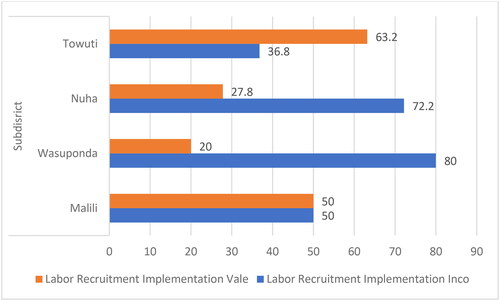
Based on the data in , it can be seen that the implementation of labor recruitment for local communities for respondents in the Malili District assessed PT Vale is still as good as PT Inco with a perceived value of 50 percent. Meanwhile, in Towuti District, PT Vale is considered better than the previous company with data of 63.2 percent for PT Vale and 36.8 percent for PT Inco. It was different in the other two sub-districts where the people’s perception in Wasuponda and Nuha sub-districts was that the previous company (PT Inco) was considered better than PT Vale in recruiting local workers. The data shows an uneven condition by the current company (PT Vale) in absorbing local workers to be involved in mining activities either as Vale employees or absorbed into the workforce as local or national contractors. Implementing local workforce recruitment can be understood more from the perceptions of interest groups seen in .
The data in shows that in general, interest groups in the local community, namely women leaders, fishermen/farmers, community leaders, traditional leaders, and local entrepreneurs, considered the absorption of local workers during the PT Inco is still better than PT Vale. As for those who favour PT Vale, this originates only from the employee group. Meanwhile, the government apparatus group considers the same regarding recruiting PT Vale with the previous company. The data shows that only the company’s internal interest group assesses the recruitment of local workers by PT Vale is better than the previous company. While external interest groups assess the process of absorbing local workers by PT Vale is still low.
3.4. Improving economic conditions
Economic growth in a region must be supported by developing infrastructures that encourage increased production of goods and services, population mobility, and smooth trade between regions. Economic growth can have an impact on increasing people’s welfare. The presence of a mining company in the midst of society certainly does not only provide profit for entrepreneurs and the government but it is also hoped that it can support improving the quality of life of the surrounding community by reducing poverty and unemployment rates.
The presence of mining companies in East Luwu has impacted the economic growth of the surrounding communities. This is also perceived by the local community as shown in . Based on the data in it can be seen that PT Vale has been assessed as having a better impact on improving people’s economic conditions with a perceived value of 53.95 compared to PT Inco is 46.05. The data shows that the community values PT Vale in mining activities has improved the community’s economic conditions more than the previous company.
The impact of the presence of mining companies on changes in the community’s economic conditions can be seen in its distribution in the four empowerment areas. More details can be seen in .
Figure 8. Community perceptions in the four districts of improving economic conditions.
Source: Primary Data Processing, March 2023.
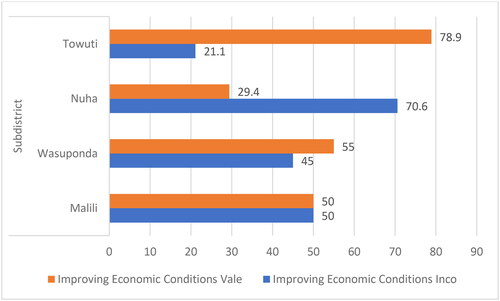
From the data in , it can be seen that in Malili District, PT Inco and PT Vale is equally impactful at providing benefits in improving the economic conditions of the community, meanwhile for the Towuti and Wasuponda Districts, PT Vale is considered to provide better benefits than the previous company. It’s interesting that in Nuha District, which is the closest area to the factory, PT Inco is perceived in favour at providing benefits to improve the economic conditions of local communities. This data shows the implementation of the CSR program from PT Vale encourages economic development that are more felt in areas that are quite far from the center of mining activities.
Furthermore, perceptions of changes in local community economic conditions can be viewed from interest groups in the four empowerment areas. The description of the survey data for interest groups can be seen in .
Figure 9. Stakeholder perceptions of improving economic conditions.
Source: Primary Data Processing, March 2023.
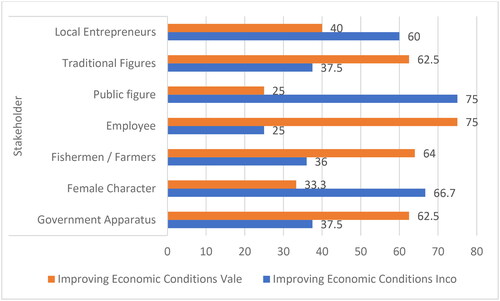
From the data in , it can be seen that overall the local community values PT Vale has benefited from improving the local community’s economic conditions a little better than the previous company. The data is supported by four interest groups, namely government officials, fishermen/farmers, Vale employees, and traditional leaders. However, it is worth paying attention to three other interest groups, namely women leaders, community leaders, and local entrepreneurs who actually considered the previous company (PT Inco) to be better in improving the economic conditions of local communities. Even in the community leader respondent group, data were found quite far apart, namely 75 percent and 25 percent. Community leaders are the dominant actors in society who are very aware of the condition of the people at the lowest level.
4. Discussion
Local communities is one of the stakeholders who are directly or indirectly connected with various CSR benefit programs carried out by mining companies in their area. Of course, it is wrong if the company only claims the success of various CSR programs without paying attention to the perceptions of the local community, especially in this case the interest groups in the area. CSR activities are carried out to accommodate the wishes and needs of stakeholders so that the company can operate properly with all the support of these stakeholders (Dixon & Coulson, Citation1995).
The findings of this study reveal information on the assessment of interest groups in the area around the mine on the benefits of CSR that were felt during the company’s management by PT Inco and PT Vale. A number of assumptions among interest groups that PT Vale is better than the previous company and the contrary is proven through the results of this survey by measuring the dimensions of environmental management, social, employment, and economic improvement as the concept in Corporate Sustainability Reporting is divided into 3 categories, namely economic performance, environmental performance, and social performance (Jenkins, Citation2004). While CSR disclosure in the GRI Index is an aspect of labor separated from the economic aspect, one of the indicators of workforce disclosure is seen from the equality of employment opportunities for local communities.
This study illustrates that on the environmental dimension, environmental management is carried out by PT Vale is currently perceived by the local community as better than during PT Inco. Data analysis for each of these regions shows that in the area farthest from the company’s smelter, environmental management is still considered balanced between the PT Inco and PT Vale. While the area closest to the factory is perceived by PT Vale is better than PT Inco, even though the data for the Towuti sub-district is still somewhat balanced. Likewise, in the assessment the interest groups perceive PT Vale is still better at environmental management compared to PT Inco. Even though it is still perceived as low by the group of female leaders. This is in line with a past study that shows that efforts to preserve the environment by companies will bring a number of benefits, one of which is the interest of shareholders and stakeholders in the company’s profits due to responsible environmental management (Pflieger et al., Citation2005).
In addition, research findings on the dimensions of the implementation of social programs reveal the social assistance programs carried out by PT Vale as the manager of the company currently has not had a significant impact on local communities. Respondents were more supportive of the program from the previous company, namely PT Inco, which provides greater and direct benefits for community empowerment. Meanwhile, from the point of view of interest groups, only four groups assessed the benefits of PT Vale is better than PT Inco, namely Government Officials, Fishermen/Farmers, Traditional Leaders, and Vale Employees. There are still three groups who consider the benefits of the previous company (PT Inco) to be better than the current company (PT Vale). Namely groups of women leaders, community leaders, and local entrepreneurs. This means that the empowerment and social assistance programs from PT Vale has not provided benefits evenly to various interest groups in the mining area. This needs to be the company’s concern, since social programs have a major impact on the sustainability of mining operations. Because there is a positive relationship between social performance and economic performance (Asare & Darkoh, Citation2001; Dikgwatlhe & Mulenga, Citation2023; Owusu-Koranteng, Citation2008). The benefits of CSR in the social field for local communities, especially for interest actors, will support a conducive business atmosphere.
Research findings on the dimensions of employment show that PT Vale since its existence in 2012, has not provided better benefits in absorbing local workers than the previous company (PT Inco). This was also reinforced by the perceptions of interest groups in general, namely women leaders, fishermen/farmers, community leaders, traditional leaders, and local entrepreneurs who considered the absorption of local workers during the PT Inco is still better than PT Vale. The data is supported by four interest groups, namely government officials, fishermen/farmers, Vale employees, and traditional leaders. However, it is worth paying attention to three other interest groups, namely women leaders, community leaders, and local entrepreneurs who actually considered the previous company (PT Inco) to be better in improving the economic conditions of local communities. This could be a concern, in which lack of support by certain local communities may threaten the sustainability of a company’s operations. As a past study has shown, if there is an inconsistency between the company’s value system and the community’s value system, the company will lose its legitimacy (Lindblom, Citation1994).
How can we make sense of these revealed perspectives? The favoring of PT Inco in areas of employment and social programs reveals that there is a pragmatic shift to perceptions within areas close to mining operations. Local communities favor programs that provide tangible benefits to the community. As the stakeholder theory argues, it is only in situations in which there is value provided that companies would eventually be supported by locals. Locals expect mining companies to provide employment opportunities that family members can benefit from, and they also wish that social programs would advance in alignment to the increasing mining operations taking place.
A second argument to make sense of the stakeholder’s perspectives in this study is by assessing why there are deficiencies to employment and social programs given to locals near mining companies. A probable cause is the increasing operational costs to manage mining companies in Sulawesi. Another could be related to the issue of globalization introduced in the introduction section of this study. With the digitalization of the economy, more administrative roles tend to be replaced by digital automatization, leading to more technical, engineering degree-related works only to be available. Consequently, this has impacted employment opportunties, and the lack of innovative social programs that could impact the society’s favorable perspective to PT Vale. Consequently, the results of this study constrasts the stakeholder theory in which it does not confirm that organizations actually pay stronger attention to the needs of the stakeholders.
The results of this study, however, confirms the importance of the stakeholder management theory. It shows that in order to have a favored perception among the community, it is vital for organization’s to identify relevant stakeholders, understand their perspectives, and act in accordance (policy development). Without this, CSR programs runs the risk of not effectively addressing the concerns held by locals located in close proximity or affected by mining operations.
5. Conclusion
Perceptions of interest groups in relation to the performances of CSR programs executed by PT Vale as the current mining company, and PT Inco as the previous company, can be assessed in the four dimensions specified in this study. In the dimension of environmental management, environmental management carried out by PT Vale is currently perceived by the local community as better than during PT Inco. This is supported by data from each district and the perceptions of interest groups. Only in the women’s group, the previous company (PT Inco) was still considered better. As for the social dimension, various social assistance programs are carried out by PT Vale has not been perceived as better than PT Inco. However, from the point of view of interest groups, namely Government Apparatuses, Fishermen/Farmers, Traditional Leaders, and Employees, assess the social program of PT Vale is better than PT Inco. Only women leaders, community leaders, and local entrepreneurs rate PT Inco better.
The dimension of absorption of local workers to work in companies, PT Vale still is undervalued compared to the previous company. Women leaders, fishermen/farmers, community leaders, traditional leaders, and local entrepreneurs considered the absorption of local workers during the PT Inco is still better than PT Vale. As for those who think that PT Vale in favour, this perception is only held by the employee group. Meanwhile, the government apparatus group considers the same regarding recruiting PT Vale with the previous company. Meanwhile, in the dimension of improving the economic conditions of the community, PT Vale in East Luwu is considered to still be better than the previous company. The data is supported by four interest groups, namely government officials, fishermen/farmers, Vale employees, and traditional leaders. However, it is worth paying attention to three other interest groups, namely women leaders, community leaders, and local entrepreneurs who actually considered the previous company (PT Inco) to be better in improving the economic conditions of local communities. This opens up future inquiries to the study of mining CSR programs, which focuses on the perceptions of specific stakeholders that may disapprove operations related to mining companies.
Last, there are several actionable recommendations that could be taken by PT Vale to enhance stakeholder’s perspectives across its CSR programs. First, in alignment to the stakeholder management theory, PT Vale needs to conduct studies that properly investigates the actors and their perspectives related to mining operations. The planning of CSR programs in the future must be in alignment to those thoughts, incorporating what matters for those affected. Second, a pragmatic approach to CSR is needed. As the study shows, there is a higher expectation among stakeholders demanding social programs and employment opportunities. Intensifying the quantity and quality of existing CSR programs can help alleviate such concerns, making innovative opportunities to the locals.
Authors’ contributions
Sawedi Muhammad (acquisition, analysis, final approval), Suryanto Arifin (analysis, interpretation of data), Ridwan Syam (analysis, drafting), Sukri Tamma (final approval, analysis), Amril Hans (drafting), Zarag Arwieny Hanami (analysis), Aprianto Aprianto (analysis), Bama Andika Putra (drafting).
Informed consent statement
Informed consent was obtained from all subjects involved in the study (verbal). A written consent was not possible to be secured due to the requests of the subjects involved.
Institutional review board statement
Ethics approval from Universitas Hasanuddin, reference number 00323/UN4.22/PT.01.03/2023
Disclosure statement
No potential conflict of interest was reported by the author(s).
Data availability statement
Data may be obtained upon request to the authors.
Correction Statement
This article has been corrected with minor changes. These changes do not impact the academic content of the article.
Additional information
Funding
Notes on contributors
Sawedi Muhammad
Sawedi Muhammad is a lecturer at the Sociology Department, Universitas Hasanuddin, Indonesia. He completed his undergraduate education at Hasanuddin University, Master’s degree at Ateneo de Manila University, and Doctoral degree at Makassar State University. He’s scientific concentration is in the fields of the sociology of conflict and community development.
Suryanto Arifin
Suryanto Arifin is a lecturer at the Sociology Department, Universitas Hasanuddin, Indonesia. Suryanto’s research focus is currently on participative development planning, within sociological discourses.
Ridwan Syam
Ridwan Syam is a lecturer at the Sociology Department, Universitas Hasanuddin, Indonesia. Ridwan’s research focus is currently on the field of social planning, within sociological discourses.
Sukri Tamma
Sukri Tamma is a lecturer at the Department of Politics, Universitas Hasanuddin, Indonesia. His Doctoral Degree was attained from the Institute of Southeast Asian Studies, Bonn University, Germany (2018), and he currently serves as the Dean of the Faculty of Social and Political Sciences, Universitas Hasanuddin.
Amril Hans
Amril Hans is a lecturer at the Department of Public Administration, Universitas Hasanuddin, Indonesia. His Doctoral Degree was attained from the Public Administration program of Universitas Hasanuddin, and currently focuses on research topics related to private public partnership and disaster governance.
Zarah Arwieny Hanami
Zarah Arwieny Hanami is a lecturer at the Department of Environmental Engineering, Universitas Hasanuddin, Indonesia. Zarah’s research focus is currently on the fields of environmental engineering, air pollution, and adsorption.
Aprianto
Aprianto is a lecturer at the International Trade Study Program, Mega Buana University, Palopo, Indonesia. Aprianto’s research focus is currently on the fields of regional politics and its connection to local development.
Bama Andika Putra
Bama Andika Putra is an International Relations lecturer in the Department of International Relations, Universitas Hasanuddin, Indonesia. His research focuses on Indonesian foreign policy, Southeast Asian regional dynamics, ASEAN, and International Security. He is currently undergoing his PhD at the School of Sociology, Politics, and International Studies, University of Bristol, United Kingdom.
References
- Allendorf, T., Swe, K. K., Oo, T., Htut, Y., Aung, M., Aung, M., Allendorf, K., Hayek, L. A., Leimgruber, P., & Wemmer, C. (2006). Community attitudes toward three protected areas in Upper Myanmar (Burma). Environmental Conservation, 33(4), 1–16. https://doi.org/10.1017/S0376892906003389
- Amoako, K. O., Lord, B. R., & Dixon, K. (2017). Insights from the websites of five plants operated by Newmont Mining Corporation. Meditari Accountancy Research, 25(2), 186–215. https://doi.org/10.1108/MEDAR-02-2016-0020
- Amponsah-Tawiah, K., & Mensah, J. (2015). Exploring the link between corporate social responsibility and health and safety in the mines. Journal of Global Responsibility, 6(1), 65–79. https://doi.org/10.1108/JGR-09-2014-0029/FULL/XML
- Ansu-Mensah, P., Marfo, E. O., Awuah, L. S., & Amoako, K. O. (2021). Corporate social responsibility and stakeholder engagement in Ghana’s mining sector: A case study of Newmont Ahafo mines. International Journal of Corporate Social Responsibility, 6(1), 1–22. https://doi.org/10.1186/s40991-020-00054-2
- Asare, B. K., & Darkoh, M. B. K. (2001). Socio-Economic and Environmental Impacts of Mining inBotswana: A Case Study of the Selebi-Phikwe Copper-Nickel Mine. Eastern Africa Social Science Research Review, 17(2), 1–42. https://www.ajol.info/index.php/eassrr/article/view/22718
- Buhmann, K. (2023). Addressing a human rights paradox in the green transition: Guidance for invested mining operations to benefit local communities. Journal of Cleaner Production, 419, 137903. https://doi.org/10.1016/j.jclepro.2023.137903
- Devenin, V., & Bianchi, C. (2018). Soccer fields? What for? Effectiveness of corporate social responsibility initiatives in the mining industry. Corporate Social Responsibility and Environmental Management, 25(5), 866–879. https://doi.org/10.1002/csr.1503
- Dikgwatlhe, P., & Mulenga, F. (2023). Perceptions of local communities regarding the impacts of mining on employment and economic activities in South Africa. Resources Policy, 80, 103138. https://doi.org/10.1016/j.resourpol.2022.103138
- Dixon, R., & Coulson, A. B. (1995). Environmental risk and management strategy: The implications for financial institutions. International Journal of Bank Marketing, 13(2), 22–29. https://doi.org/10.1108/02652329510078668/FULL/PDF
- Dubiński, J. (2013). Sustainable development of mining mineral resources. Journal of Sustainable Mining, 12(1), 1–6. https://doi.org/10.7424/jsm130102
- Erb, M. (2016). Mining and the conflict over values in Nusa Tenggara Timur province, eastern Indonesia. Extractive Industries and Society. 3(2), 370–382.
- Fitzpatrick, P., Fonseca, A., & McAllister, M. L. (2011). From the whitehorse mining initiative towards sustainable mining: Lessons learned. Journal of Cleaner Production, 19(4), 376–384. https://doi.org/10.1016/j.jclepro.2010.10.013
- Freudenreich, B., Lüdeke-Freund, F., & Schaltegger, S. (2020). A stakeholder theory perspective on business models: Value creation for sustainability. Journal of Business Ethics, 166(1), 3–18. https://doi.org/10.1007/S10551-019-04112-Z/FIGURES/2
- Garriga, E., & Melé, D. (2004). Corporate social responsibility theories: Mapping the territory. Journal of Business Ethics, 53(1/2), 51–71. https://doi.org/10.1023/B:BUSI.0000039399.90587.34
- Gifford, B., & Kestler, A. (2008). Toward a theory of local legitimacy by MNEs in developing nations: Newmont mining and health sustainable development in Peru. Journal of International Management, 14(4), 340–352. https://doi.org/10.1016/j.intman.2007.09.005
- Gilbert, D. U., & Rasche, A. (2008). Opportunities and problems of standardized ethics initiatives - A stakeholder theory perspective. Journal of Business Ethics, 82(3), 755–773. https://doi.org/10.1007/S10551-007-9591-1/METRICS
- Govindan, K., Kannan, D., & Shankar, K. M. (2014). Evaluating the drivers of corporate social responsibility in the mining industry with multi-criteria approach: A multi-stakeholder perspective. Journal of Cleaner Production, 84(1), 214–232. https://doi.org/10.1016/j.jclepro.2013.12.065
- Hąbek, P., & Wolniak, R. (2016). Assessing the quality of corporate social responsibility reports: The case of reporting practices in selected European Union member states. Quality & Quantity, 50(1), 399–420. https://doi.org/10.1007/S11135-014-0155-Z/TABLES/11
- Harvey, D. (2005). The new imperialism. Oxford University Press.
- Imbun, B. Y. (2007). Cannot manage without the “significant other”: Mining, corporate social responsibility and local communities in Papua New Guinea. Journal of Business Ethics, 73(2), 177–192. https://www.jstor.org/stable/25075411 https://doi.org/10.1007/s10551-006-9189-z
- Jenkins, H. (2004). Corporate social responsibility and the mining industry: Conflicts and constructs. Corporate Social Responsibility and Environmental Management, 11(1), 23–34. https://doi.org/10.1002/csr.50
- Jonek-Kowalska, I. (2016). Sustainable development as a challenge for Polish coal mining enterprises. Zeszyty Naukowe Politechniki Slaskiej, Organizacja i Zarzadzanie, 95, 1–23.
- Kepore, K. P., & Imbun, B. Y. (2011). Mining and stakeholder engagement discourse in a Papua New Guinea mine. Corporate Social Responsibility and Environmental Management, 18(4), 220–233. https://doi.org/10.1002/csr.243
- Kurlander, L. T. (2001). Newmont mining: The social license to operate. Proceedings of the Global Executive Forum.
- Libassi, M. (2022). Gold conflict and contested conduct: Large-and small-scale mining subjectivities in Indonesia.
- Lindblom, C. K. (1994). The implications of organizational legitimacy for corporate social performance and disclosure. Critical Perspectives on Accounting Conference.
- Luxemburg, R. (2003). The struggle against natural economy and international loans. In The accumulation of capital. Routledge and Kegan Paul LTD. https://www.routledge.com/The-Accumulation-of-Capital/Luxemburg/p/book/9780415304450
- Maier, R. M., Díaz-Barriga, F., Field, J. A., Hopkins, J., Klein, B., & Poulton, M. M. (2014). Socially responsible mining: The relationship between mining and poverty, human health and the environment. Reviews on Environmental Health, 29(1–2), 83. https://doi.org/10.1515/reveh-2014-0022
- Matikainen, L. S. (2022). Addressing sustainability in the mining industry through stakeholder engagement. South Asian Journal of Business and Management Cases, 11(1), 35–48. https://doi.org/10.1177/22779779221078673/ASSET/IMAGES/LARGE/10.1177_22779779221078673-FIG3.JPEG
- Moomen, A. W., & Dewan, A. (2017). Probing the perspectives of stakeholder engagement and resistance against large-scale surface mining in developing countries. Corporate Social Responsibility and Environmental Management, 24(2), 85–95. https://doi.org/10.1002/csr.1396
- Mutti, D., Yakovleva, N., Vazquez-Brust, D., & Di Marco, M. H. (2012). Corporate social responsibility in the mining industry: Perspectives from stakeholder groups in Argentina. Resources Policy, 37(2), 212–222. https://doi.org/10.1016/j.resourpol.2011.05.001
- Mzembe, A. N., & Meaton, J. (2014). Driving corporate social responsibility in the Malawian mining industry: A stakeholder perspective. Corporate Social Responsibility and Environmental Management, 21(4), 189–201. https://doi.org/10.1002/csr.1319
- Ormsby, A., & Kaplin, B. A. (2005). A framework for understanding community resident perceptions of Masoala National Park, Madagascar. Environmental Conservation, 32(2), 156–164. https://doi.org/10.1017/S0376892905002146
- Owen, J. R., & Kemp, D. (2012). Assets, capitals, and resources. Business & Society, 51(3), 382–408. https://doi.org/10.1177/0007650312446803
- Owusu-Koranteng, D. (2008). Mining investment & community struggles. Review of African Political Economy, 35(117), 467–473. https://doi.org/10.1080/03056240802411115
- Pflieger, J., Fischer, M., Kupfer, T., & Eyerer, P. (2005). The contribution of life cycle assessment to global sustainability reporting of organizations. Management of Environmental Quality: An International Journal, 16(2), 167–179. https://doi.org/10.1108/14777830510583182/FULL/PDF
- Ramakrishnan, P. S. (2007). Traditional forest knowledge and sustainable forestry: A north-east India perspective. Forest Ecology and Management, 249(1-2), 91–99. https://doi.org/10.1016/j.foreco.2007.04.001
- Raufflet, E., Cruz, L. B., & Bres, L. (2014). An assessment of corporate social responsibility practices in the mining and oil and gas industries. Journal of Cleaner Production, 84(1), 256–270. https://doi.org/10.1016/j.jclepro.2014.01.077
- Rodrigues, M., & Mendes, L. (2018). Mapping of the literature on social responsibility in the mining industry: A systematic literature review. Journal of Cleaner Production, 181, 88–101. https://doi.org/10.1016/j.jclepro.2018.01.163
- Sharma, D., & Bhatnagar, P. (2015). Corporate social responsibility of mining industries. International Journal of Law and Management, 57(5), 367–372. https://doi.org/10.1108/IJLMA-03-2014-0022/FULL/PDF
- Strand, R., Freeman, R. E., & Hockerts, K. (2015). Corporate social responsibility and sustainability in Scandinavia: An overview. Journal of Business Ethics, 127(1), 1–15. https://doi.org/10.1007/S10551-014-2224-6/FIGURES/6
- Urbina, C., & Schäfer, J. (2024). Human rights due diligence as a risk management instrument for the mining industry in an energy transition scenario: Assessing the Chilean experience. Journal of Energy & Natural Resources Law, 42(1), 1–20. https://doi.org/10.1080/02646811.2024.2303273
- Vale. (2021). PT Vale. Annual Report. https://vale.com/indonesia
- Ventura, J., & Saenz, C. S. (2015). Beyond corporate social responsibility. Towards a model for managing sustainable mining operations, Qualitative research based upon best practices. Social Responsibility Journal, 11(3), 605–621. https://doi.org/10.1108/SRJ-06-2014-0077/FULL/PDF
- Viveros, H. (2016). Examining stakeholders’ perceptions of mining impacts and corporate social responsibility. Corporate Social Responsibility and Environmental Management, 23(1), 50–64. https://doi.org/10.1002/csr.1363
- Vodouhê, F. G., Coulibaly, O., Adégbidi, A., & Sinsin, B. (2010). Community perception of biodiversity conservation within protected areas in Benin. Forest Policy and Economics, 12(7), 505–512. https://doi.org/10.1016/j.forpol.2010.06.008
- Yang, X., & Ho, P. (2019). Is mining harmful or beneficial? A survey of local community perspectives in China. The Extractive Industries and Society, 6(2), 584–592. https://doi.org/10.1016/j.exis.2019.02.006
- Yousefian, M., Bascompta, M., Sanmiquel, L., & Vintró, C. (2023). Corporate social responsibility and economic growth in the mining industry. The Extractive Industries and Society, 13, 101226. https://doi.org/10.1016/j.exis.2023.101226

